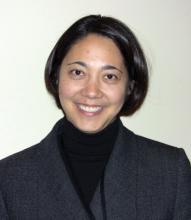CHICAGO – A small study provides compelling data that both the genotype and phenotype of non-small cell lung cancers can transform as part of acquired resistance to tyrosine kinase inhibitors.
Repeat tumor biopsies revealed that the histologic diagnosis of the tumor shifted from adenocarcinoma to small cell lung cancer (SCLC) in 14% of 37 consecutive patients with epidermal growth factor receptor (EGFR)-mutant non–small cell lung cancer (NSCLC) and acquired tyrosine kinase inhibitor (TKI) resistance, Dr. Lecia Sequist said during the plenary session at the Chicago Multidisciplinary Symposium in Thoracic Oncology.
The original L858R mutation or E 19 deletion was retained in all cases but, in one patient, an additional PIK3CA mutation was observed only when the tumor shifted to SCLC.
Although other groups have documented sporadic case reports of transformation, Dr. Sequist called the 14% transformation rate remarkable. "I think this points to a broader conceptual model of acquired resistance, and we need to think very carefully about doing more repeat biopsies in patients," she said.
EGFR-mutant NSCLC is highly sensitive to EGFR TKI therapy, but acquired resistance develops at about 9-12 months due to T790M mutations in half of patients and MET amplification in 10% to 15%. Elucidating the remaining mechanisms of drug resistance is of great clinical and scientific significance, said Dr. Sequist of Massachusetts General Hospital Cancer Center, Boston.
Although re-biopsy is not common practice, invited discussant Dr. Mark Socinski said it should be on the clinicians’ radar because it can alter the therapeutic course of refractory disease and arguably the clinical benefit.
"I think the message here is to consider re-biopsy more often in selected patients until we have a better understanding of this one disease we call non–small lung cancer that we realize is an incredibly heterogenous disease," said Dr. Socinski, director of the multidisciplinary thoracic oncology program at the Lineberger Comprehensive Cancer Center at the University of North Carolina–Chapel Hill.
Among the five patients whose cancer transformed, two maintained a slow, indolent course after SCLC transformation, while three had a change around the time of their biopsy to an explosive growth pattern more clinically reminiscent of SCLC, Dr. Sequist said. Four patients were treated with SCLC-like chemotherapy regimens, and three responded with marked partial responses.
Longitudinal data from fluorescent in situ hybridization analysis for MET and EGFR gene copy number suggest that the resistant tumor is distinct from the original tumor and that MET amplification lies in a distinct subpopulation of the cell and is selected out under pressure from TKI therapy, she said.
Multiple biopsies over time also identified a waxing and waning of genotypic and phenotypic findings in response to selective pressure of TKI therapy. This pattern was most pronounced in a case that transformed from EGFR TKI-sensitive adenocarcinoma to resistant SCLC while on erlotinib (Tarceva) for more than one year, switched back to TKI-sensitive adenocarcinoma following treatment with chemotherapy and radiation and a 9- to 10-month break from erlotinib, and then after a very successful, but short-lived re-response to erlotinib, shifted back to SCLC a second time upon clinical resistance.
"It’s showing us that if you do repeat biopsies, it can direct patients towards clinical trials that they have a higher likelihood of benefiting from," Dr. Sequist said. "It’s a really a nice thing to be able to offer patients."
The population comprised 15 men and 22 women. All patients, median age 60 years, had clinically responded to either gefitinib (Iressa) or erlotinib, with a median of 18.4 months of initial EGFR TKI therapy (range 4-69 months). The majority, or 81%, remained on TKI at the time of repeat biopsy. Repeat biopsy showed T790m mutations in 49%, PIK3CA in 5%, MET amplification in 5%, and an unknown mechanism in 30%, reported Dr. Sequist at the symposium, cosponsored by the American Society of Clinical Oncology, American Society for Radiation Oncology, International Association for the Study of Lung Cancer, and University of Chicago.
Dr. Sequist and Dr. Socinski disclosed no relevant conflicts. Two coauthors have submitted a patent for genotyping methods.

